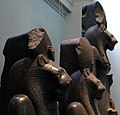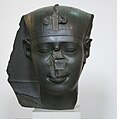
The British Museum is a public museum dedicated to human history, art and culture located in the Bloomsbury area of London. Its permanent collection of eight million works is the largest in the world. It documents the story of human culture from its beginnings to the present. The British Museum was the first public national museum to cover all fields of knowledge.
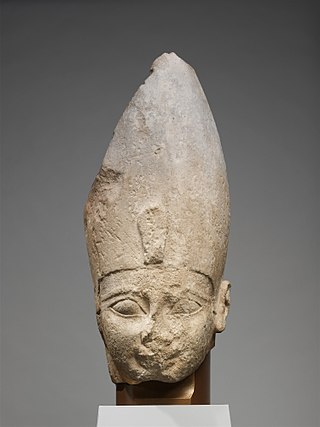
Ahmose I was a pharaoh and founder of the Eighteenth Dynasty of Egypt, classified as the first dynasty of the New Kingdom of Egypt, the era in which ancient Egypt achieved the peak of its power. He was a member of the Theban royal house, the son of pharaoh Seqenenre Tao and brother of the last pharaoh of the Seventeenth Dynasty, Kamose. During the reign of his father or grandfather, Thebes rebelled against the Hyksos, the rulers of Lower Egypt. When he was seven years old, his father was killed, and he was about ten when his brother died of unknown causes after reigning only three years. Ahmose I assumed the throne after the death of his brother, and upon coronation became known as Nebpehtyre, nb-pḥtj-rꜥ "The Lord of Strength is Ra".
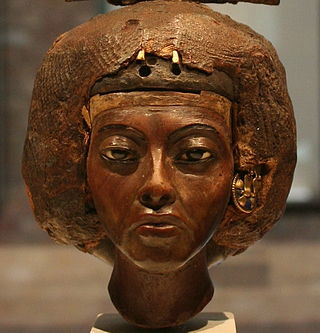
Tiye was the Great Royal Wife of the Egyptian pharaoh Amenhotep III, mother of pharaoh Akhenaten and grandmother of pharaoh Tutankhamun; her parents were Yuya and Thuya. In 2010, DNA analysis confirmed her as the mummy known as "The Elder Lady" found in the tomb of Amenhotep II (KV35) in 1898.

The Museum of Egyptian Antiquities, commonly known as the Egyptian Museum, located in Cairo, Egypt, houses the largest collection of Egyptian antiquities in the world. It houses over 120,000 items, with a representative amount on display. Located in Tahrir Square in a building built in 1901, it is the largest museum in Africa. Among its masterpieces are Pharaoh Tutankhamun's treasure, including its iconic gold burial mask, widely considered one of the best-known works of art in the world and a prominent symbol of ancient Egypt.

Amenhotep III, also known as Amenhotep the Magnificent or Amenhotep the Great and Hellenized as Amenophis III, was the ninth pharaoh of the Eighteenth Dynasty. According to different authors, he ruled Egypt from June 1386 to 1349 BC, or from June 1388 BC to December 1351 BC/1350 BC, after his father Thutmose IV died. Amenhotep was Thutmose's son by a minor wife, Mutemwiya.

Menpehtyre Ramesses I was the founding pharaoh of ancient Egypt's 19th Dynasty. The dates for his short reign are not completely known but the timeline of late 1292–1290 BC is frequently cited as well as 1295–1294 BC. While Ramesses I was the founder of the 19th Dynasty, his brief reign mainly serves to mark the transition between the reign of Horemheb, who had stabilized Egypt in the late 18th Dynasty, and the rule of the powerful pharaohs of his own dynasty, in particular his son Seti I, and grandson Ramesses II.

Thutmose I was the third pharaoh of the 18th Dynasty of Egypt. He received the throne after the death of the previous king, Amenhotep I. During his reign, he campaigned deep into the Levant and Nubia, pushing the borders of Egypt farther than ever before in each region. He also built many temples in Egypt, and a tomb for himself in the Valley of the Kings; he is the first king confirmed to have done this.

Tetisheri was the matriarch of the Egyptian royal family of the late 17th Dynasty and early 18th Dynasty.
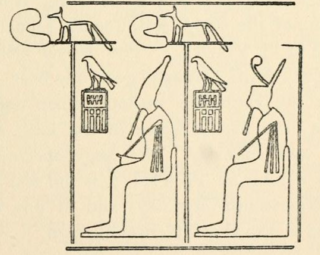
Djer is considered the third pharaoh of the First Dynasty of ancient Egypt in current Egyptology. He lived around the mid 31st century BC and reigned for c. 40 years. A mummified forearm of Djer or his wife was discovered by Egyptologist Flinders Petrie, but was discarded by Émile Brugsch.

Titkheperure or Tyetkheperre Psusennes II [Greek Ψουσέννης] or Hor-Pasebakhaenniut II [Egyptian ḥr-p3-sb3-ḫˁỉ-⟨n⟩-nỉwt], was the last king of the Twenty-first Dynasty of Egypt. His royal name means "Image of the transformations of Re" in Egyptian. Psusennes II is often considered the same person as the High-Priest of Amun known as Psusennes III. The Egyptologist Karl Jansen-Winkeln notes that an important graffito from the Temple of Abydos contains the complete titles of a king Tyetkheperre Setepenre Pasebakhaenniut Meryamun "who is simultaneously called the HPA and supreme military commander." This suggests that Psusennes was both king at Tanis and the High Priest in Thebes at the same time, meaning he did not resign his office as High Priest of Amun during his reign. The few contemporary attestations from his reign include the aforementioned graffito in Seti I's Abydos temple, an ostracon from Umm el-Qa'ab, an affiliation at Karnak and his presumed burial – which consists of a gilded coffin with a royal uraeus and a Mummy, found in an antechamber of Psusennes I's tomb at Tanis. He was a High Priest of Amun at Thebes and the son of Pinedjem II and Istemkheb. His daughter Maatkare B was the Great Royal Wife of Osorkon I.

Ancient Egyptian art refers to art produced in ancient Egypt between the 6th millennium BC and the 4th century AD, spanning from Prehistoric Egypt until the Christianization of Roman Egypt. It includes paintings, sculptures, drawings on papyrus, faience, jewelry, ivories, architecture, and other art media. It was a conservative tradition whose style changed very little over time. Much of the surviving examples comes from tombs and monuments, giving insight into the ancient Egyptian afterlife beliefs.

Luxor Museum is an archaeological museum in Luxor, Egypt. It stands on the corniche, overlooking the east bank of the River Nile.
In ancient Egypt, cats were represented in social and religious scenes dating as early as 1980 BC. Several ancient Egyptian deities were depicted and sculptured with cat-like heads such as Mafdet, Bastet and Sekhmet, representing justice, fertility, and power, respectively. The deity Mut was also depicted as a cat and in the company of a cat.

Ahhotep I was an ancient Egyptian queen who lived circa 1560–1530 BC, during the end of the Seventeenth Dynasty of Egypt. She was the daughter of Queen Tetisheri and Senakhtenre Ahmose, and was probably the sister, as well as the queen consort, of Pharaoh Seqenenre Tao ll. Ahhotep I had a long and influential life. She ruled as regent for her son Ahmose I for a time.

Amenhotep (Huy) was the high steward of Memphis under Amenhotep III in the Egyptian 18th Dynasty. With this title he was one of the highest officials at the royal court.
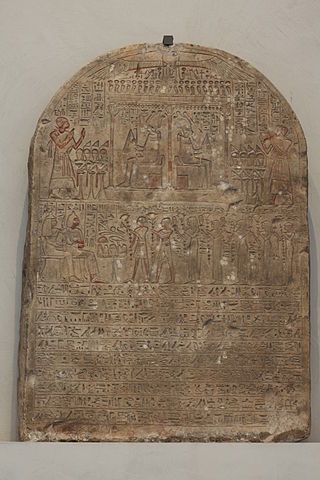
Ptahmose was a High Priest of Amun and Vizier of southern Egypt-(Upper Egypt), under Amenhotep III. Certain historians place him at the end of the reign in 1378 BC. Others place him in the first part of the reign.

The Eighteenth Dynasty of Egypt is classified as the first dynasty of the New Kingdom of Egypt, the era in which ancient Egypt achieved the peak of its power. The Eighteenth Dynasty spanned the period from 1550/1549 to 1292 BC. This dynasty is also known as the Thutmosid Dynasty for the four pharaohs named Thutmose.
This page list topics related to ancient Egypt.

The Department of Egyptian Antiquities of the Louvre is a department of the Louvre that is responsible for artifacts from the Nile civilizations which date from 4,000 BC to the 4th century. The collection, comprising over 50,000 pieces, is among the world's largest, overviews Egyptian life spanning Ancient Egypt, the Middle Kingdom, the New Kingdom, Coptic art, and the Roman, Ptolemaic, and Byzantine periods.
The archaeology of Ancient Egypt is the study of the archaeology of Egypt, stretching from prehistory through three millennia of documented history. Egyptian archaeology is one of the branches of Egyptology.







